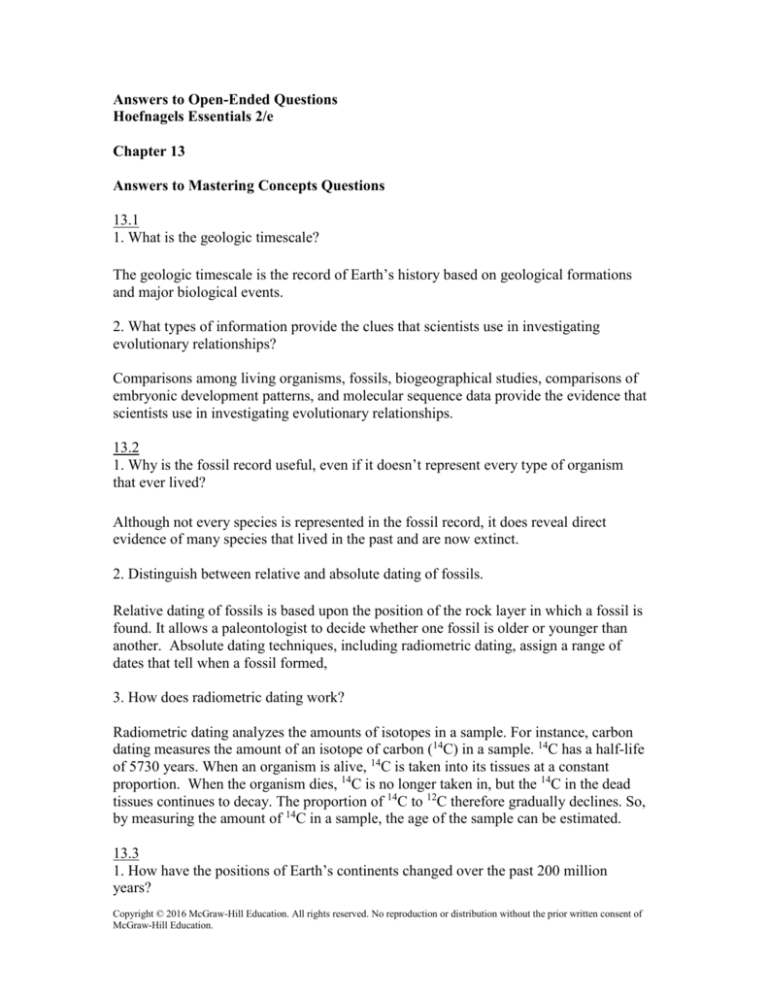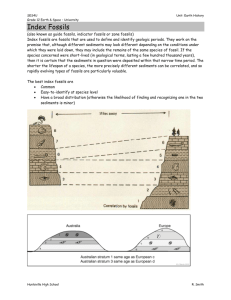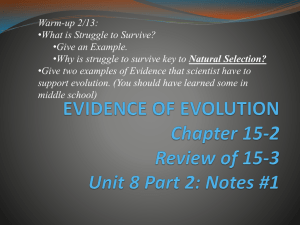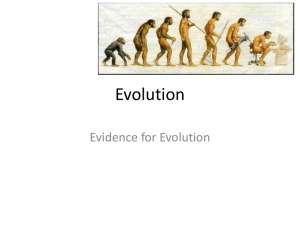
Answers to Open-Ended Questions
Hoefnagels Essentials 2/e
Chapter 13
Answers to Mastering Concepts Questions
13.1
1. What is the geologic timescale?
The geologic timescale is the record of Earth’s history based on geological formations
and major biological events.
2. What types of information provide the clues that scientists use in investigating
evolutionary relationships?
Comparisons among living organisms, fossils, biogeographical studies, comparisons of
embryonic development patterns, and molecular sequence data provide the evidence that
scientists use in investigating evolutionary relationships.
13.2
1. Why is the fossil record useful, even if it doesn’t represent every type of organism
that ever lived?
Although not every species is represented in the fossil record, it does reveal direct
evidence of many species that lived in the past and are now extinct.
2. Distinguish between relative and absolute dating of fossils.
Relative dating of fossils is based upon the position of the rock layer in which a fossil is
found. It allows a paleontologist to decide whether one fossil is older or younger than
another. Absolute dating techniques, including radiometric dating, assign a range of
dates that tell when a fossil formed,
3. How does radiometric dating work?
Radiometric dating analyzes the amounts of isotopes in a sample. For instance, carbon
dating measures the amount of an isotope of carbon (14C) in a sample. 14C has a half-life
of 5730 years. When an organism is alive, 14C is taken into its tissues at a constant
proportion. When the organism dies, 14C is no longer taken in, but the 14C in the dead
tissues continues to decay. The proportion of 14C to 12C therefore gradually declines. So,
by measuring the amount of 14C in a sample, the age of the sample can be estimated.
13.3
1. How have the positions of Earth’s continents changed over the past 200 million
years?
Copyright © 2016 McGraw-Hill Education. All rights reserved. No reproduction or distribution without the prior written consent of
McGraw-Hill Education.
Over the past 200 million years, Earth’s continents have drifted apart from a central,
global landmass to their present positions as separate entities. They are continuing to
move in different directions, riding on tectonic plates.
2. How do biogeographical observations help biologists interpret evolutionary history?
Biogeography is the study of the distribution of species across the planet. Studying
biogeography helps explain some observations that might otherwise be puzzling. For
example, plate tectonics explains why fossils of marine species appear on mountaintops,
why fossils of the same extinct species are distributed across multiple continents, and
why Australia and New Zealand have more native marsupial species than other
continents.
13.4
1. What can homologous structures reveal about evolution?
Homologous anatomical structures reveal how natural selection can mold the same basic
parts into structures with different functions.
2. What is a vestigial structure? What are some examples of vestigial structures in
humans and other animals?
A vestigial structure is nonfunctional, but it is homologous to a functional structure in
related organisms. The muscles that erect our body hair, the tails of human embryos, and
the muscles that allow us to wiggle our ears are vestigial structures. The eyes of moles
and the leg bones of snakes and whales also are vestigial structures.
3. What is convergent evolution?
Convergent evolution produces similar adaptations in unrelated organisms, thanks to
similar selective pressures in different locations on Earth’s surface.
13.5
1. How does the study of embryonic development reveal clues to a shared evolutionary
history?
Similar physical traits are the result of similar developmental processes. Ultimately, these
developmental pathways have their origin in genes, which are inherited from a shared
common ancestor.
2. Why are evolutionary biologists interested in how genes influence development?
Evolutionary biologists are interested in how genes influence development because they
shed light on the genetic changes that are involved in evolution of new phenotypes from
an ancestral type.
Copyright © 2016 McGraw-Hill Education. All rights reserved. No reproduction or distribution without the prior written consent of
McGraw-Hill Education.
13.6
1. How does analysis of DNA and proteins support other evidence for evolution?
Molecular analysis supports evidence for evolution because it is highly unlikely that two
unrelated species would evolve identical DNA or protein sequences. Biochemical
similarities derive from a common ancestor; differences arise from mutations that
occurred after two species diverged from a common ancestor. Thus, the more similar the
DNA or protein sequences, the closer the evolutionary relationship.
2. How can molecular clocks help determine when two species diverged from a common
ancestor?
A molecular clock uses the known mutation rate for a gene to estimate how long ago two
species diverged from a common ancestor.
Write It Out
1. What types of information are used to determine how species are related to one another
by descent from shared ancestors? Give an example of how multiple types of evidence
can support one another.
The evidence includes observations of living organisms, fossils, biogeography,
comparisons of embryonic structures, and molecular sequences. Human evolution
provides one example: anatomical similarities reveal that humans are primates, fossils
and biogeography reveal that humans originated in Africa along with other ape species
(see section 17.12), and similarities in DNA and protein sequences support the hypothesis
that chimpanzees are the closest relatives to humans.
2. Why are transitional fossils especially useful for understanding evolutionary
relationships?
Transitional fossils are useful because they provide direct evidence of common ancestry,
even for species that diverged long ago. For example, the discovery of fossils of
Tiktaalik, an animal that had features resembling both fish and amphibians, provided
additional evidence that these two vertebrate groups are closely related.
3. The bubonic plague swept through western Europe in 1348. Suppose researchers use
14
C dating on the skeletons of suspected plague victims, and they discover that about 50%
of the original amount of 14C remains in the bones. Are the bones the remains of plague
victims?
The bones are not the remains of plague victims. If 50% of the original 14C remains, then
the bones are about 5730 years old. (One half-life for 14C is 5730 years.) The plague
epidemic happened hundreds of years ago, not thousands.
Copyright © 2016 McGraw-Hill Education. All rights reserved. No reproduction or distribution without the prior written consent of
McGraw-Hill Education.
4. Index fossils represent organisms that were widespread but lived during relatively
short periods of time. How are index fossils useful in relative dating?
If an index fossil is found in association with a fossil of unknown date, the index fossil
(which is from a known, brief period) can provide a narrow range of relative dates for the
unknown fossil.
5. How do molecular sequences provide different information than relative and absolute
dating?
Relative dating and absolute dating provide the ages of fossils; however, molecular
sequences provide information about approximate dates for speciation events or the
appearance of mutations in a population.
6. Suppose that collaborating research teams found fossils of the same extinct species in
eastern South America and western Africa. What can the researchers conclude about the
age of these fossils without using absolute or relative dating techniques?
Biogeography helps the researchers understand the distribution of this extinct species.
The fossils must predate the time when South America and Africa were united as one
continent (see figure 13.5), well over 100 million years ago.
7. How was the discovery of Wallace’s line evidence for the predictive power of
evolution?
Wallace’s line is an imaginary line that divides the organisms of Australia from those of
southeast Asia. Wallace noticed differences between organisms on each side of this line,
suggesting that the regions must have been separated for a long time. The deep trench
separating the islands was later discovered.
8. Why is it important for evolutionary biologists to be able to distinguish between
homologous and analogous anatomical structures?
If two structures are homologous, then there are similarities between them that reflect a
common ancestry. Analogous structures appear superficially similar, but the structures
have evolved independently.
9. Suppose that plants in the San Francisco Bay area and in southern Chile share a
common seed dispersal method. Scientists determine that the evolutionary divergence of
these plants happened long before this seed dispersal method arose in each plant. What
term relates the seed dispersal method of the San Francisco Bay plant to the seed
dispersal method of the southern Chile plant? Explain your answer.
Copyright © 2016 McGraw-Hill Education. All rights reserved. No reproduction or distribution without the prior written consent of
McGraw-Hill Education.
The seed dispersal methods are analogous. They provide an example of convergent
evolution because the seed dispersal method originated independently after the two plant
species last shared a common ancestor.
10. Explain why a researcher might combine evidence from fossils and from the anatomy
of existing organisms when creating an evolutionary tree.
Combining these lines of evidence allows a researcher to determine what groups of
existing organisms share a common ancestor. For example, fossils allow researchers to
determine which features in living organisms arose recently and which are found in
ancestral organisms.
11. Suggest a type of genetic change that could have a drastic effect on the evolution of a
species.
A mutation in a homeotic gene could produce a totally new trait, such as the addition or
the loss of limbs. The new phenotype may increase fitness and become widespread in the
species. It could also lead to an entirely new species, if individuals with the new
phenotype no longer mate with individuals that have the “original” phenotype (see
chapter 14).
12. Give examples of how the field of evolutionary developmental biology uses evidence
from anatomical comparisons and from homeotic genes.
Homeotic genes help explain how a few small mutations in key developmental genes can
have profound phenotypic effects. For example, two homeotic genes influence limb
development in vertebrates. The pattern of expression of these two genes determines
whether the animal will form limbs. The fruit fly with legs growing out of its head in
figure 7.13 also illustrates how manipulating key developmental genes can have striking
effects of anatomy.
13. Some genes are more alike between human and chimp than other genes are from
person to person. Does this mean that chimps are humans or that humans with different
alleles are different species? What other explanation fits the facts?
No. Although chimps and humans share a common ancestor (and therefore share many
genes), they are reproductively isolated from one another so they are different species.
Genes that are very similar between humans and chimps may be the most important
genes (that is, mutations in those genes may be fatal, slowing their rate of change).
Genes that vary within a population may not be essential to survival or may have mutated
after the two species diverged from their common ancestor.
14. Search the Internet to learn about evidence suggesting that birds and dinosaurs are
closely related. If scientists could extract DNA from dinosaur fossils, how could they use
the sequences to learn more about the origin of birds?
Copyright © 2016 McGraw-Hill Education. All rights reserved. No reproduction or distribution without the prior written consent of
McGraw-Hill Education.
DNA from dinosaur fossils could be useful in learning more about specific events in
reptile evolution. For example, it could reveal a particular gene that mutated and gave a
selective advantage to birds.
15. Why are molecular clocks useful, and what are their limitations?
If biologists know the mutation rate for any gene, plus the number of differences in the
DNA sequences for that gene in two species, they can use the DNA as a molecular clock
to estimate the time when the organism diverged from a common ancestor. One limitation
is that not all DNA sequences mutate at the same rate; another is molecular clocks are not
accurate if too much time has passed since two species last shared a common ancestor.
16. Genetic anthropology combines the study of DNA with physical evidence such as
fossils to reveal the history of the human species. Use the Internet to research the goals
and methods of the Genographic Project, HapMap, or the Human Genome Diversity
Project. What are the benefits of these projects? What ethical issues arise from this type
of research?
The Genographic Project maps the migration patterns of humans from our last common
ancestral population to today. It uses DNA samples from hundreds of thousands of
volunteers around the world and analyzes it with sophisticated software programs. The
HapMap project looks at genetic similarities and differences among people around the
world to search for DNA sequences of genetic diseases. The DNA samples are donated
anonymously from four populations. The Human Genome Diversity Project collects cell
lines from individuals around the world, documenting the genetic diversity in the human
population and making the DNA available to researchers. Benefits could include better
understanding of many diseases, how different populations arrived at their current
geographic location, and how population groups are related. Ethical issues could include
misuse of individual’s DNA information, stigmatizing groups based on genetic
information, or interfering with religious or cultural explanations of origins.
17. Evolutionary biologists often try to assign an approximate date when two organisms
last shared a common ancestor. Why do you think that molecular evidence often yields an
earlier date than fossil evidence?
Molecular evidence would be apparent from approximately the point of mutation.
Physical evidence in the form of a fossil would have to rely on expression of the mutation
in an organism that died under just the right circumstances to be fossilized. Since this is a
rare event, the likelihood of its happening right after the mutation’s appearance is slim.
Pull It Together
1. Provide an example of each line of evidence for evolution.
Copyright © 2016 McGraw-Hill Education. All rights reserved. No reproduction or distribution without the prior written consent of
McGraw-Hill Education.
(1) Fossils reveal that the ancestors of modern snakes had limbs. (2) Biogeography: The
distribution of marsupial fossils, taken together with evidence for how Earth’s continents
have moved, reveals that placental mammals outcompeted marsupials, leading to many
extinctions. (3) Anatomy: Vestigial eyes of moles suggest their ancestor had functional
eyes. (4) Development: The early stages of embryonic development in mammals are
similar; an early embryonic mouse looks similar to the early stage of a human. This
supports the hypothesis that all mammals are derived from a common ancestor. (5)
Molecular: Cytochrome c sequences are more similar among mammals than between a
mammal and a bird.
2. Write a phrase to connect fossils and biogeography and a separate phrase to connect
DNA and anatomy.
“Fossils” could connect with the phrase “locations are part of the study of” to
“Biogeography.” “Anatomy” could connect with the phrase “reflects the expression of”
to “DNA.”
3. Add the following terms to this concept map: homologous structures, vestigial
structures, homeotic genes, and molecular clock.
“Homologous structures” leads with “appear in” to “Anatomy” and to “Life’s
molecules.” “Vestigial structures” leads with “are clues to common ancestry in” to
“Anatomy.” “Homeotic genes” leads with “strongly influence” to “Development.”
“Molecular clock” leads with “uses known mutation rates in” to “DNA.”
Copyright © 2016 McGraw-Hill Education. All rights reserved. No reproduction or distribution without the prior written consent of
McGraw-Hill Education.









